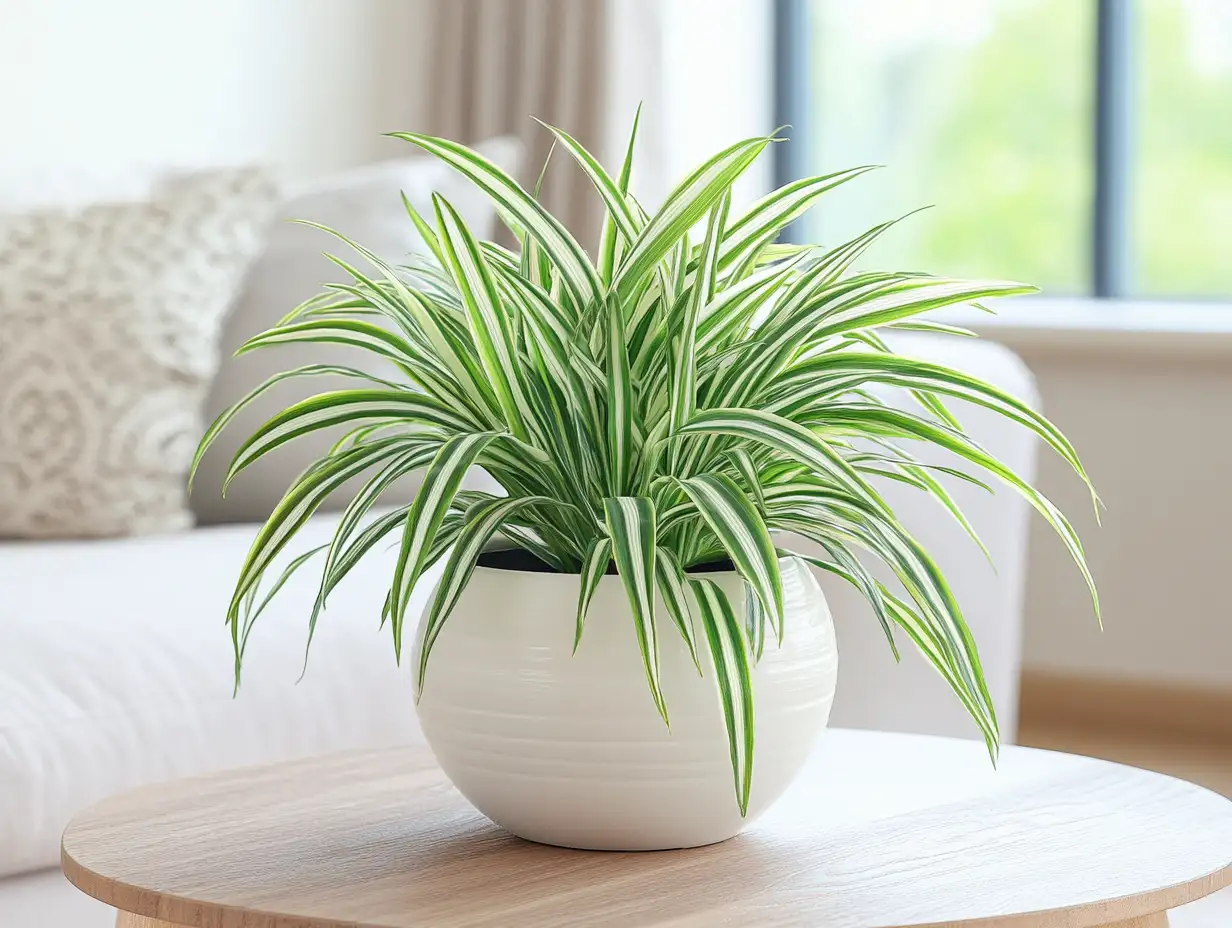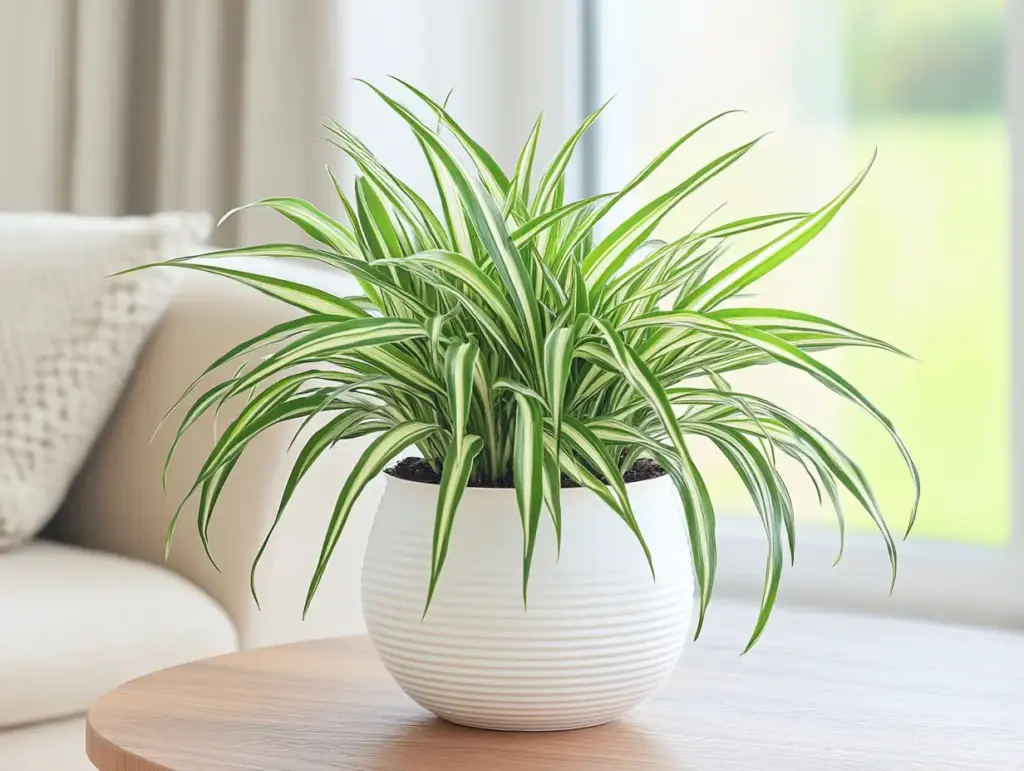Spider plant care is a rewarding and straightforward way to bring fresh greenery into your home. Known scientifically as Chlorophytum comosum, these popular indoor plants are beloved for their easygoing nature and striking arching leaves.
Often called airplane plants, spider plants are perfect for beginners and seasoned plant enthusiasts alike. With their graceful, trailing foliage and charming baby spiderettes, they add instant charm and a touch of natural beauty to any room.
If you’re looking to style your space, check out our houseplants for living room guide for inspiration. You might also love exploring our indoor plant styling tips for creative ways to showcase your plants.
Let’s dive into the essentials of spider plant care, so you can cultivate a thriving, vibrant plant that will brighten your home for years to come.
🌿 Love gardening inspiration? Follow me on Pinterest for bold plant ideas, tips, and seasonal color!
Table of Contents
☀️ Light Requirements
When it comes to spider plant care, providing the right light conditions is key to a thriving plant. Spider plants thrive in bright, indirect light, which mimics their natural habitat on the forest floor beneath a canopy of leaves. Place your plant near an east-facing window where it can enjoy gentle morning sunlight without the risk of scorching. If direct sunlight streams through a window, use a sheer curtain to diffuse the rays and protect those delicate leaves.
Although spider plants can tolerate lower light conditions, you may notice slower growth or fewer spiderettes if the light is too dim. In such cases, move your plant to a brighter spot, and watch as it quickly perks up. Remember, consistent, filtered light is one of the simplest ways to achieve lush, vibrant spider plant care.
🌡️ Temperature & Humidity
A crucial aspect of spider plant care is maintaining the right temperature and humidity to keep your plant healthy and happy. Spider plants prefer temperatures between 65°F and 75°F (18°C to 24°C), making them perfect companions for typical indoor environments. They can tolerate brief dips in temperature down to 50°F (10°C), but exposure to cold drafts or frigid conditions can stress the plant and stunt its growth.
Moderate humidity levels help spider plants thrive. If your home is on the drier side—especially during the winter months—consider grouping your spider plant with other houseplants to create a mini humidity zone, or use a humidifier to maintain moisture in the air. Remember, if you’re comfortable, your spider plant likely is too!
💧 Watering
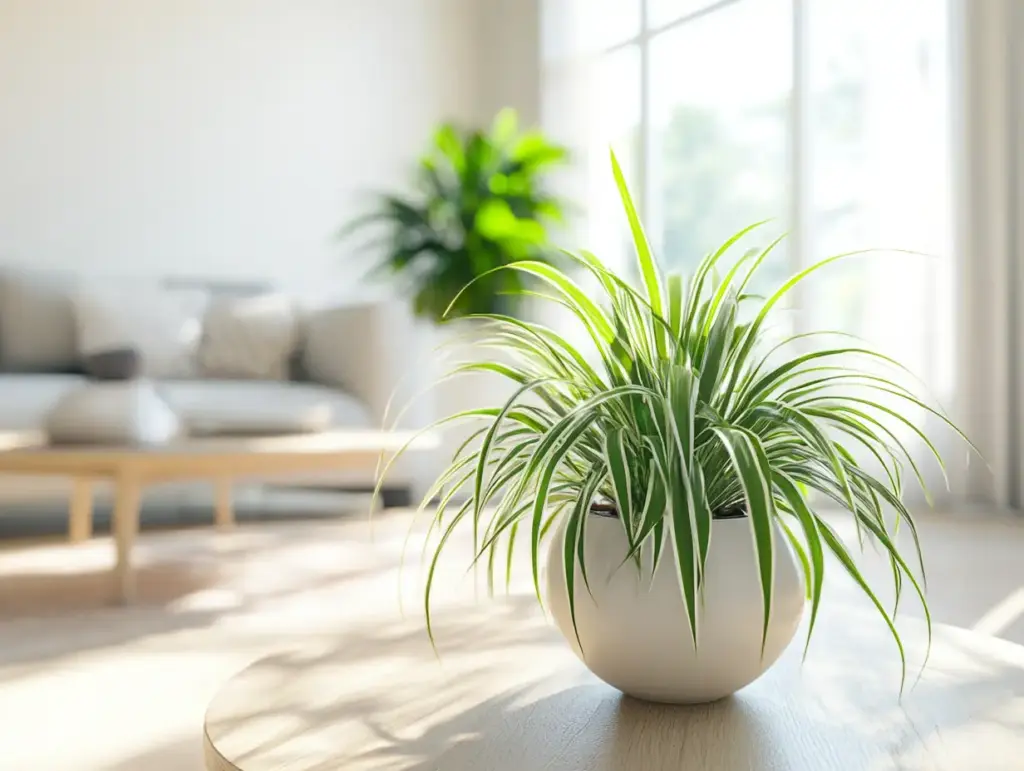
Mastering the art of watering is key to successful spider plant care. These resilient plants prefer their soil to dry out slightly between waterings, so let the top inch of soil feel dry before reaching for your watering can. When you do water, give it a thorough drink until excess water drains from the bottom—ensuring the entire root system is properly hydrated.
Overwatering is one of the most common pitfalls in spider plant care and can lead to root rot, a condition that’s tough to reverse. If your plant looks droopy even though the soil feels damp, it might be time to check the roots for signs of decay.
During the warmer months, spider plants may need more frequent watering, while in cooler months you can scale back. Always monitor the leaves for signs of underwatering (brown tips or crispy edges) or overwatering (yellowing or mushy leaves) and adjust your routine accordingly.
🪴 Soil & Drainage
When it comes to spider plant care, choosing the right soil and ensuring proper drainage are essential to prevent issues like root rot. Spider plants thrive in a well-draining potting mix that includes perlite or coarse sand. These components promote good airflow around the roots and help water drain quickly, keeping the plant’s roots healthy and oxygenated.
Make sure to use a pot with drainage holes at the bottom. Without them, excess water can accumulate and suffocate the roots, leading to fungal problems and root decay. If you notice water pooling at the bottom, consider using a pebble tray or elevating the pot slightly to help with drainage.
A slightly acidic to neutral pH is ideal for spider plants, but they’re forgiving and can adapt to a range of standard houseplant mixes. By prioritizing well-draining soil and a breathable environment, your spider plant will flourish with fewer issues and happier roots.
🌿 Fertilizing
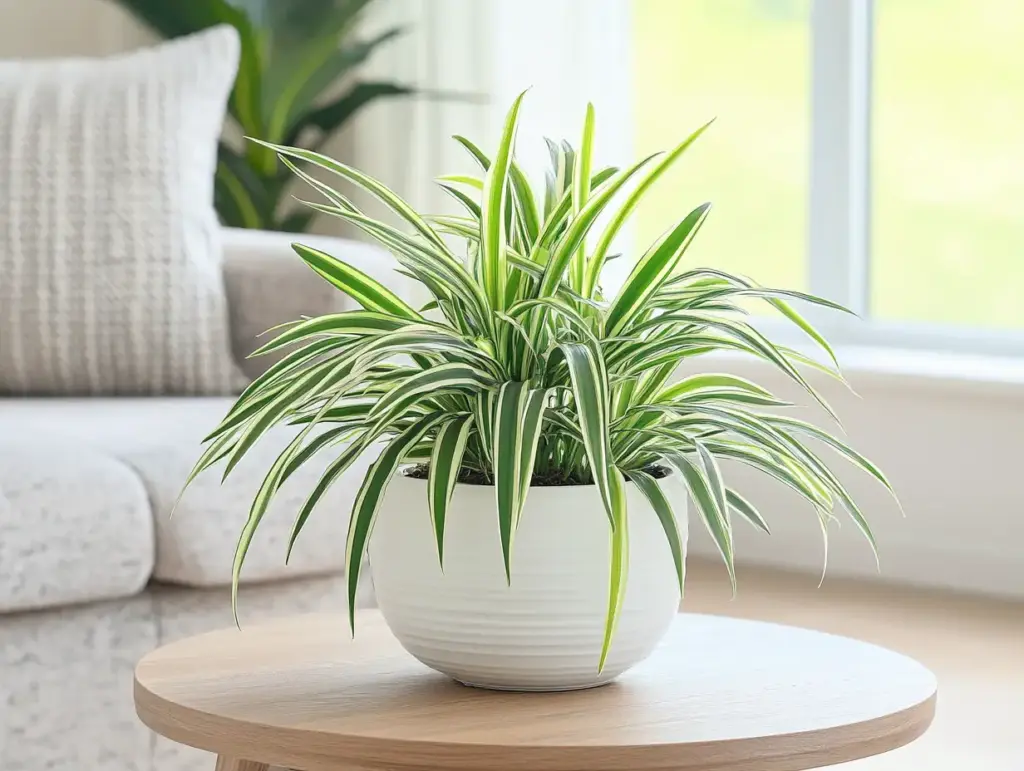
Fertilizing is a helpful yet often overlooked aspect of spider plant care that can make a big difference in your plant’s vibrancy. During the growing season—typically spring and summer—feed your spider plant every 4 to 6 weeks using a balanced liquid fertilizer diluted to half strength. This encourages lush, healthy foliage and supports the growth of those delightful spiderettes.
Be careful not to overfeed; too much fertilizer can lead to brown leaf tips and salt buildup in the soil. If you notice this, flush the soil occasionally by thoroughly watering to wash away excess salts. During the plant’s dormant period in fall and winter, reduce fertilizing to once every couple of months or stop altogether to allow your spider plant to rest.
With a simple, consistent fertilizing routine, your spider plant care efforts will be rewarded with vibrant growth and a healthier, happier plant.
✂️ Pruning & Maintenance
Regular pruning and maintenance keep your spider plant looking its best and encourage new growth. One common issue you might encounter in spider plant care is brown leaf tips. These can result from low humidity, salt buildup, or even hard tap water. To fix this, use clean, sharp scissors to trim just the brown tip, taking care not to cut into the healthy green part of the leaf.
As spider plants grow, older leaves naturally yellow and die back. Don’t worry—this is normal! Simply remove these aging leaves at the base to direct your plant’s energy toward fresh, vibrant growth.
If your plant becomes crowded or starts to outgrow its pot, consider dividing it. Gently separate the root ball into smaller sections and replant them in individual pots. This not only rejuvenates your plant but also gives you more spider plants to enjoy or share with friends.
🌱 Propagation
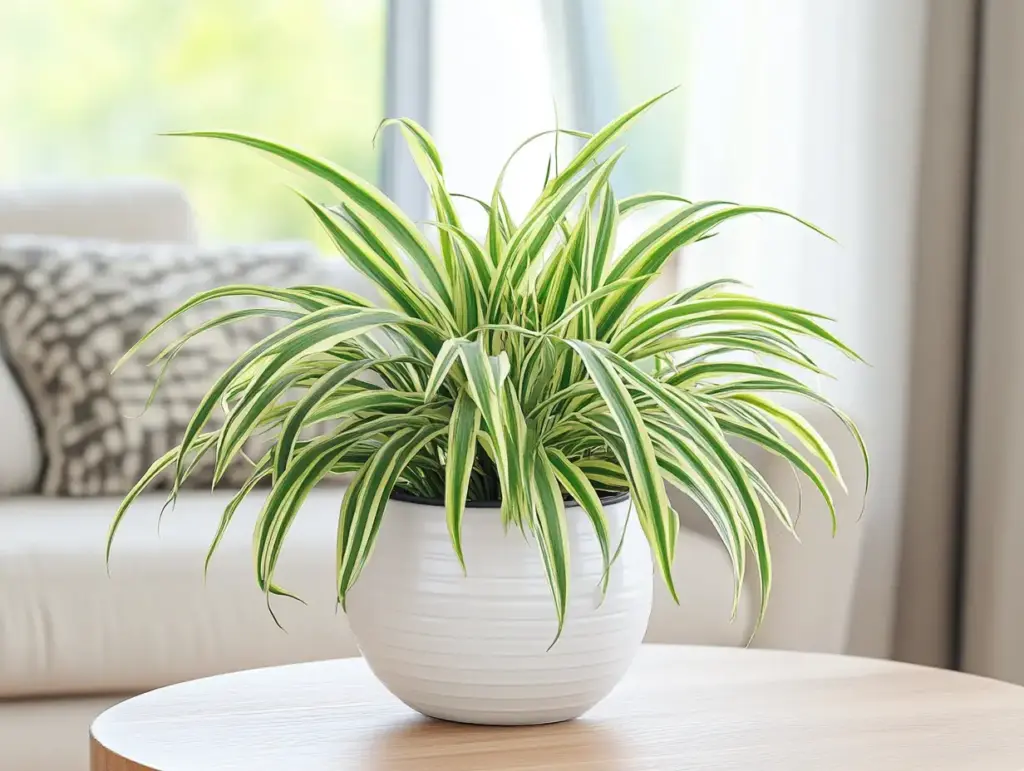
One of the most delightful parts of spider plant care is propagation, thanks to their generous production of baby plants—called spiderettes. These tiny offshoots form on long runners that dangle from the mother plant like a string of pearls, making propagation a fun and rewarding experience.
When your spider plant is healthy and receiving ample bright light, it will naturally produce spiderettes that may even develop small roots while still attached. Once those roots appear, you can gently snip the baby from the runner and place it in water or a small pot of soil.
If rooting in water, wait until the roots are a few inches long before transplanting into a well-draining potting mix. Alternatively, you can plant the spiderette directly in soil, keeping it lightly moist as it establishes itself. With proper care, you’ll soon have a thriving new spider plant to enjoy or share with fellow plant enthusiasts.
🐞 Pests & Problems
Even though spider plants are known for their resilience, it’s wise to watch for pests and common problems as part of your regular spider plant care routine. The most frequent unwanted visitors are aphids and spider mites, which can sap your plant’s strength and mar its beautiful leaves. If you spot small insects, sticky residue, or fine webbing, treat your plant by wiping the leaves with a soft, damp cloth or using a mild soapy water solution. For more stubborn infestations, insecticidal soap works wonders.
Another challenge is root rot, often caused by overwatering or poor drainage. If your spider plant looks limp and the soil is consistently damp, carefully remove the plant from its pot and inspect the roots. Trim away any mushy, brown sections and repot your plant in fresh, well-draining soil to prevent further damage.
By staying vigilant and addressing these issues early, you’ll keep your spider plant healthy, lush, and thriving for years to come.
🏡 Indoor Styling
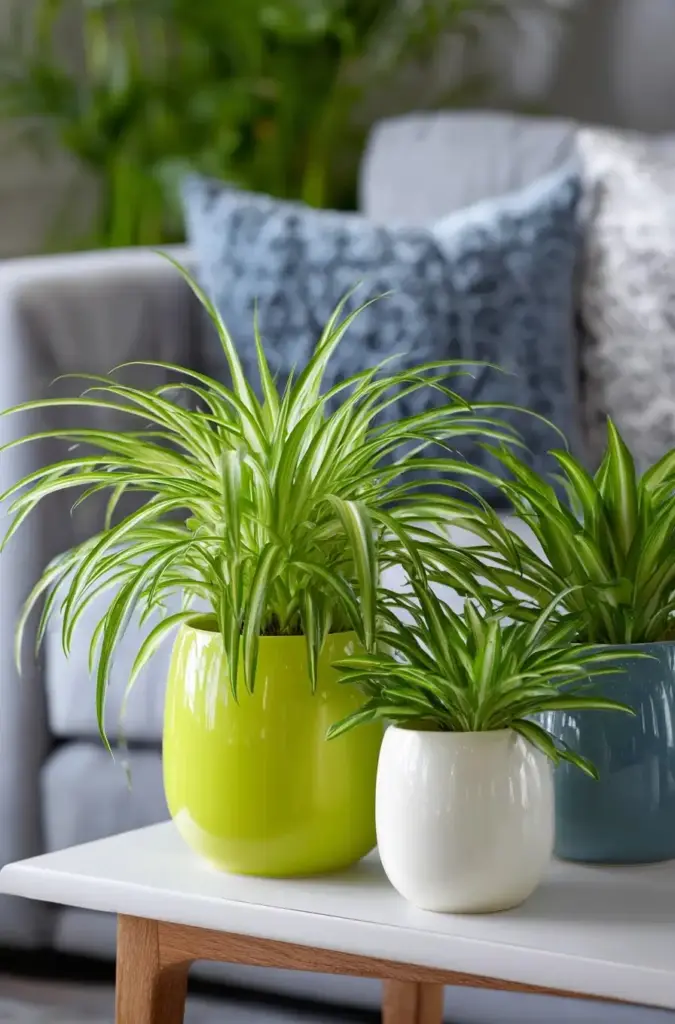
Spider plants aren’t just easy to care for—they’re also wonderfully versatile when it comes to home styling. Their arching green-and-white leaves make them ideal for adding a lively touch to any room. Consider pairing them with other houseplants like the White Bird of Paradise or a Philodendron to create a dynamic indoor jungle. This complementary greenery not only looks great but also helps maintain a balanced humidity environment, which benefits all your plants.
For creative displays, try hanging your spider plant in a macramé hanger near a bright window or nestle it on a bookshelf where the spiderettes can cascade down for a whimsical look. Just be mindful of strong afternoon sun, which can scorch the delicate leaves—filtered light works best.
By experimenting with different placements and combinations, you’ll discover how versatile spider plant care can be, bringing a refreshing and cheerful vibe to every corner of your home.
🌞 Seasonal Care
Seasonal changes are an important part of spider plant care, and understanding how to adjust your routine can make a big difference in your plant’s health. During the warmer months of spring and summer, your spider plant will be in an active growth phase, which means it may need more frequent watering to keep up with its increased thirst. Monitor the soil moisture regularly, and avoid letting it dry out completely.
In contrast, spider plants slow down in winter, so watering should be reduced to prevent waterlogged soil and root rot. Also, keep your plant away from cold drafts or direct blasts of heat from radiators, which can stress the foliage.
If your home becomes especially dry in winter, consider grouping plants together or using a humidifier to maintain a comfortable humidity level. These simple seasonal adjustments will ensure that your spider plant care routine supports a happy, thriving plant year-round.
🧳 Travel Tips
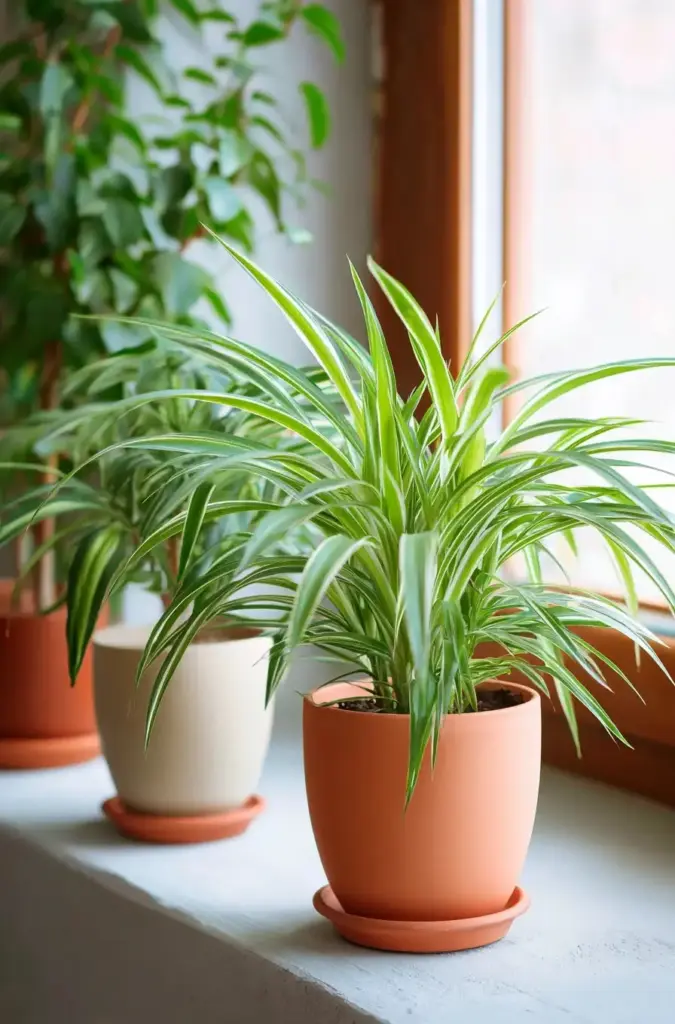
One of the best things about spider plant care is its forgiving nature, making it an excellent choice for busy plant parents and frequent travelers. Before leaving on a trip, water your spider plant thoroughly so that it’s well-hydrated. This preps your plant for a short period of neglect without missing a beat.
If you’ll be gone for an extended time, set up a simple self-watering system—like a water reservoir or a DIY wicking system—to ensure the soil stays slightly moist. Alternatively, you can ask a neighbor or a friend to check in on your plant every week or so to do the “finger test” for dryness and water if needed.
Spider plants don’t require daily care, so with a bit of planning, you can leave home with peace of mind knowing that your green companion will be waiting happily for your return.
🌸 Conclusion
Spider plant care is a rewarding and straightforward journey for plant lovers of all levels. With bright, indirect light, moderate watering, and occasional feeding, your spider plant will thrive, producing vibrant leaves and adorable spiderettes to share. Whether you’re a beginner or a seasoned green thumb, spider plants bring beauty, airiness, and a touch of charm to any home. For additional inspiration on enhancing your indoor greenery, explore our houseplants for living room or dive into creative indoor plant styling tips that will help you create the perfect lush haven.
❓ FAQs
Why do the leaf tips turn brown?
Brown tips are common in spider plant care and are often caused by low humidity, salt buildup from fertilizers, or hard tap water. Trim just the brown tips with clean scissors, being careful not to cut into the healthy green tissue.
Do spider plants really clean the air?
While some studies suggest that spider plants can help remove indoor pollutants, the effect is generally minimal. However, they definitely brighten up any room and add a touch of nature to your space, which can make your home feel fresher and more inviting.
Why isn’t my spider plant producing babies?
Spiderettes develop best when the plant receives bright, indirect light and is mature enough to produce offshoots. If your plant seems shy, try moving it to a brighter spot and wait patiently.
When should I repot my spider plant?
Repot your spider plant every one to two years, or whenever you notice roots circling the bottom of the pot or pushing up from the top. A slightly larger container will give the roots room to grow and keep your plant healthy.

